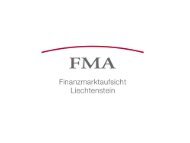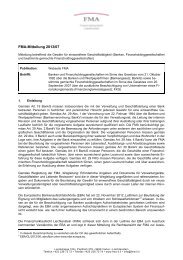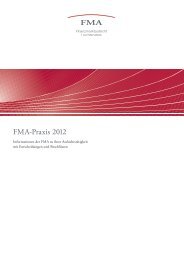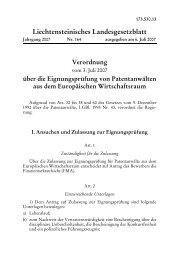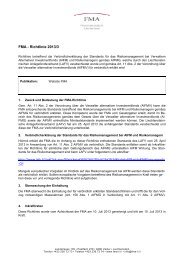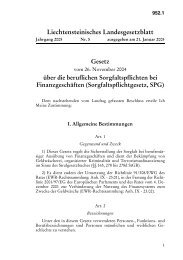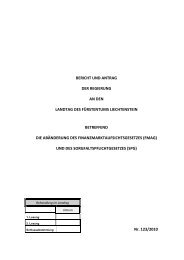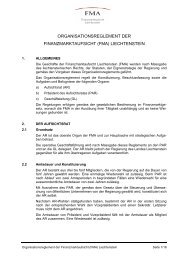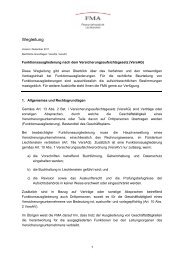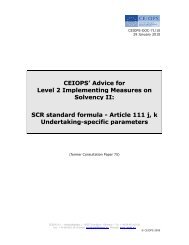CEIOPS' Advice for Level 2 Implementing ... - EIOPA - Europa
CEIOPS' Advice for Level 2 Implementing ... - EIOPA - Europa
CEIOPS' Advice for Level 2 Implementing ... - EIOPA - Europa
You also want an ePaper? Increase the reach of your titles
YUMPU automatically turns print PDFs into web optimized ePapers that Google loves.
sign ( x)<br />
= −1<br />
if x < 0 .<br />
3.179 Even after a model has been selected there is a great challenge to<br />
estimate the parameters. The policyholder behaviour may change over<br />
time and the current observed surrender pattern could be a poor<br />
prediction of future behaviour.<br />
3.180 Undertakings could also assume that mortality is independent of the<br />
financial market. A questionable but practical simplification is to assume<br />
stochastic independency between surrender rate and financial markets<br />
and between surrender rate and mortality rate.<br />
3.181 For with profit contracts the surrender option and the minimum<br />
guarantees are clearly dependent. Furthermore, management actions<br />
will also have a significant impact on the surrender options that might<br />
not easily be captured in a closed <strong>for</strong>mula.<br />
3.2.2.3. Financial options and guarantees<br />
3.182 Life insurance contracts usually have besides classical pure insurance<br />
elements also implicitly or explicitly built in different kinds of financial<br />
options and guarantees (see CEIOPS’ advice DOC-21-09 and DOC-33-09<br />
<strong>for</strong> a wider reference to these guarantees).<br />
3.183 The benefits of with-profit contracts usually consist of a guaranteed<br />
benefit and of variable extra benefit that is based on the profits the<br />
undertaking has been able to generate and that is often added to the<br />
guaranteed benefits as reversionary extra benefit or a variable terminal<br />
extra benefit that is not guaranteed until maturity.<br />
3.184 As discussed in CEIOPS-DOC-33-09, financial options and guarantees<br />
can generally be valued accordingly to two main techniques:<br />
• use observed market price if the risk factor is hedgeable on deep,<br />
liquid and transparent market<br />
• use mark-to-model if the risk factor is non-hedgeable i.e.:<br />
• stochastic simulation technique,<br />
• deterministic approach,<br />
o closed <strong>for</strong>m estimate derived from an arbitrage-free model with<br />
parameters calibrated to market prices of similar options (e.g.<br />
Black-Scholes <strong>for</strong>mula).<br />
3.185 Valuing financial options and guarantees with stochastic simulation<br />
techniques (Monte Carlo or appropriate numerical partial differential<br />
equation approaches) considers a range of future stochastically varying<br />
economic conditions (e.g. interest rates) calibrated to a market<br />
consistent assets model. The connection to market consistent prices and<br />
arbitrage-free valuation is achieved by ensuring that the asset model<br />
reproduces observed market prices <strong>for</strong> some representative assets.<br />
3.186 Deterministic approach made series of deterministic projections of the<br />
values of the underlying assets. Deterministic projection corresponds to<br />
a possible economic scenario together with the associated probability of<br />
occurrence. The cost of the financial options and guarantees equal to the<br />
41/112<br />
© CEIOPS 2010



